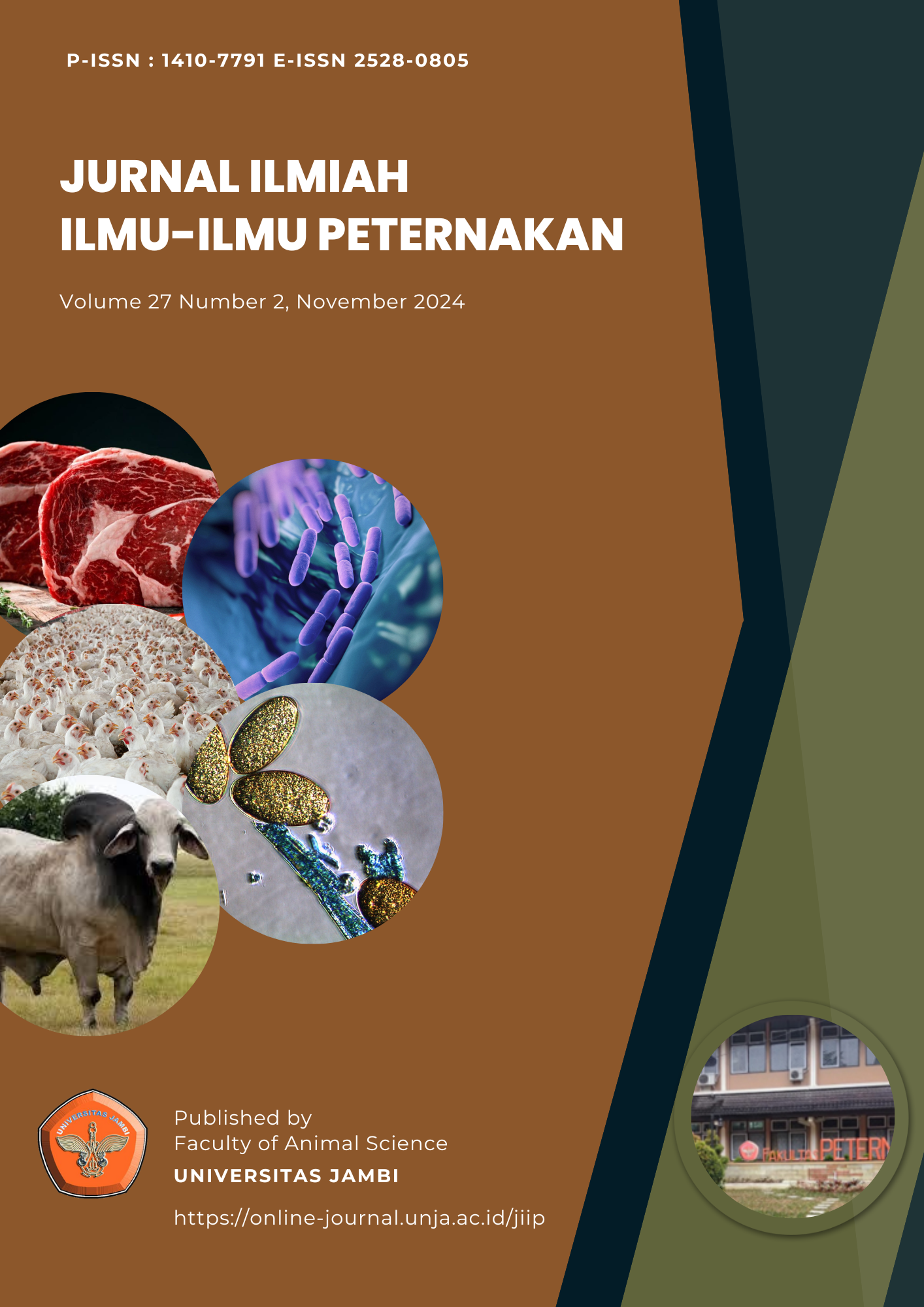Analisis Pemasaran dan Pendapatan Pedagang Sapi PO Kebumen Siap Potong di Pasar Hewan Argopeni Kecamatan Kebumen Kabupaten Kebumen
Analysis of Marketing and Income of Kebumen PO Cattle Traders Ready for Slaughter at the Argopeni Animal Market Kebumen District Kebumen Regency
DOI:
https://doi.org/10.22437/jiiip.v27i2.37017Keywords:
traders, income, breeding cow, PO Kebumen cattleAbstract
Background: This research is to determine the income of ready-to-slaughter PO Kebumen cattle traders and their marketing flow at the Argopeni Market, Kebumen District, Kebumen Regency. Purpose: This research aims to determine the percentage of sales of ready-to-slaughter PO Kebumen cattle using blantik and without blantik services at the Argopeni Animal Market, Kebumen Regency, to determine the income of ready-to-slaughter PO Kebumen cattle traders at the Argopeni Animal Market, Kebumen Regency, and to determine the influence of the profile of PO cattle traders Kebumen ready to cut as an independent variable consisting of age, experience and education on income as the dependent variable. Methods: This research is descriptive research using a survey method using a questionnaire instrument for data collection. The sampling technique in this research used a census where the sample of PO Kebumen cattle traders ready for slaughter was 10 people. The data analysis technique used to test the hypothesis is multiple linear regression analysis. Results: The results of the variance analysis show that the variables age, experience and education have a significant effect (P>0.05) on the income of ready-to-slaughter PO Kebumen cattle traders. The marketing channel for ready-to-slaughter PO Kebumen cattle at the Argopeni Animal Market which uses blantik services is 92% and those without blantik are 8%. The average income of PO Kebumen cattle traders ready for slaughter at the Kebumen Argopeni Animal Market is IDR 28,002,000/month. Based on the Multiple R value of 0.844, it shows that there is a very strong correlation between age, experience and education and income. Conclusion: Based on the research results, it can be concluded that age, experience and education simultaneously have a correlation with the income of ready-to-slaughter PO Kebumen cattle traders at the Argopeni Animal Market.
Downloads
References
Astati, A., Suarda, & Fatmah, S. I. (2016). Strategi Pemasaran Sapi Potong (Studi Kasus PT. Berdikari United Livestock Kabupaten Sidrap). Jurnal Ilmu Dan Industri Peternakan, 3(1), 36–63.
Azis, Y., & Husin, I. (2021). Efisiensi Pemasaran Sapi Potong di Kecamatan Takisung Kabupaten Tanah Laut Provinsi Kalimantan Selatan. Journal of Agricultural Socio-Economics (JASE), 2(1), 17–24. https://doi.org/10.33474/jase.v2i1.13036
Hidayat, N., Haryoko, I., Yuwono, P., & Hidayat, N. (2023). Analisis Tren Populasi dan Pengembangan Sapi PO di Kabupaten Kebumen. Prosiding Seminar Nasional Teknologi Dan Agribismis Peternakan, 298–302.
Hidayat, N. N., Haryoko, I., & Yuwono, P. (2024). Analisis Kinerja Ekonomi Usaha Ternak Sapi Potong PO Kebumen. 17–18.
Lasaharu, N., Laya, K. N., & Boekoesoe, Y. (2020). Analisis Pemasaran Sapi Potong. Journal of Animal Science, 2(2), 62–75. https://doi.org/10.35900/jjas.v2i2.5092
Leo, B. (2015). Analisa Keuntungan Lembaga Pemasaran Ternak Kambing di Kecamatan Binamu Kabupaten Jeneponto. Universitas Hasanuddin Makasar.
Misriani, V. (2011). Hubungan Karakteristik Peternak dan Jumlah Ternak Yang Dipelihara Dengan Pendapatan pada Pembibitan Sapi Potong Rakyat di Kecamatan Bayang Kabupaten Pesisir Selatan. Universitas Andalas.
Mulyadi. (2012). Akuntansi Biaya Edisi Lima. Universitas Gadjah Mada.
Mustofa, A, N., W, A., Dyah, & Alif, M. (2015). Analisis Faktor-Faktor yang Mempengaruhi Pengambilan Keputusan Peternak dalam Memulai Usaha Ternak Sapi Potong di Desa Kedungkumpul Kecamatan Sarirejo Kabupaten Lamongan. Fakultas Peternakan Universitas Islam Lamongan.
Ningsih, U. W., Hartono, B., & Nugroho, E. (2017). Analisis Pemasaran Sapi Potong Melalui Analisis Marjin, Transmisi Harga, Struktur Pemasaran, Perilaku Pemasaran dan Kinerja Pemasaran. Jurnal Ilmu-Ilmu Peternakan, 27(1), 1–11. https://doi.org/10.21776/ub.jiip.2017.027.01.01
Paly, B. (2015). Pengantar Ilmu Ekonomi Peternakan. Universitas Islam Negeri Alauddin Makassar. Makassar.
Rasyaf. (2010). Manajemen Peternakan Ayam Kampung. Penebar Swadaya, Jakarta.
Sahriani. (2020). Analisis Efisiensi Saluran Pemasaran Sapi Potong di Kecamatan Bulukumba Kabupaten Bulukumba. UIN Alauddin Makassar.
Sholeh, M. (2024). Analisis Saluran, Margin dan Efisiensi Pemasaran Ternak Sapi di Kecamatan Tungkal Jaya Kabupeten Musi Banyuasin. Universitas Jambi.
Soeharjo, A., & Patong, S. (2010). Potensi Agribisnis Usaha Ternak Sapi Potong di Kota Kendari. Jurnal Ilmu Dan Teknologi Peternakan Tropis, 1(1), 88–98.
Soeparno. (2015). Ilmu dan Teknologi Daging (2nd ed.). Gadjah Mada University press. Yogyakarta.
Subiharta, Utomo, B., & Sudrajad, P. (2012). Potensi Peranakan Ongole (PO) Kebumen Sebagai Sumber Bibit Sapi Lokal di Indonesia Berdasarkan Ukuran Tubuhnya (Studi Pendahuluan). Pengembangan Agribisnis Peternakan Menuju Swasembada Protein Hewani, 1–10.
Tinaprilla, N., & Fadly, M. A. (2022). Analisis Pendapatan Usaha Ternak Sapi Potong Communal dan Non Communal di Desa Aek Ledong Kabupaten Asahan Sumatera Utara. Risalah Kebijakan Pertanian Dan Lingkungan, 9(3), 149–160. https://doi.org/10.29244/jkebijakan.v9i3.33888
Yuliantika, I. M. Y., Adnyana, I. B. W., & Sukada, I. M. (2016). Profil Umur, Jenis Kelamin, Berat Badan dan Jejas Eksternal pada Kulit Sapi Bali yang Disembelih di Rumah Potong Hewan Kota Denpasar Periode Mei-Juni 2015. Indonesia Medicus Veterinus, 5(4), 376–387. https://pksb.unud.ac.id/img/admin/post_attc/9f3197886c004f5b7e67f9e3adee290a.pdf
Downloads
Published
How to Cite
Issue
Section
License
Copyright (c) 2024 Ismawatun, Nunur Nuraeni

This work is licensed under a Creative Commons Attribution-NonCommercial-ShareAlike 4.0 International License.











